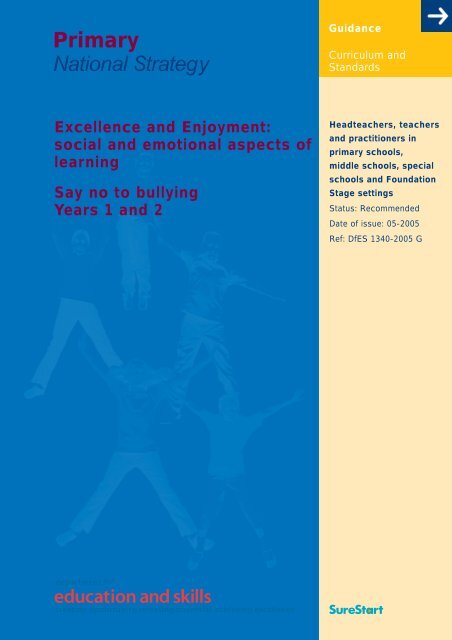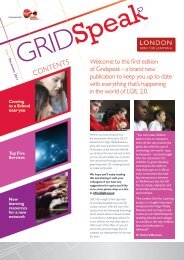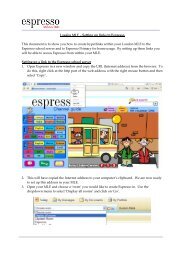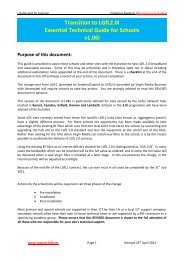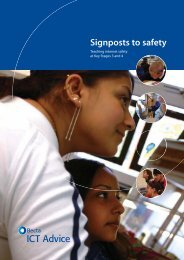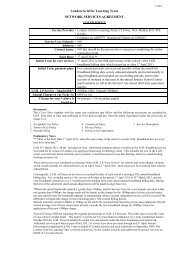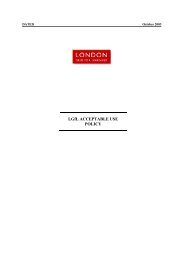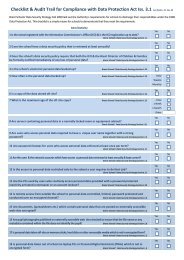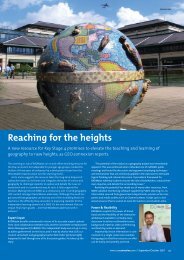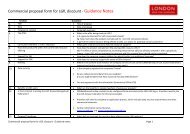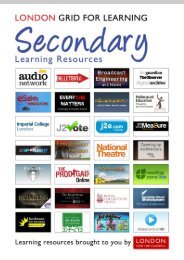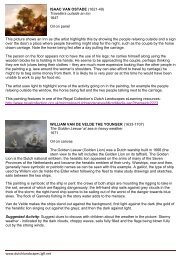Say no to bullying
Say no to bullying
Say no to bullying
Create successful ePaper yourself
Turn your PDF publications into a flip-book with our unique Google optimized e-Paper software.
PrimaryNational StrategyGuidanceCurriculum andStandardsExcellence and Enjoyment:social and emotional aspects oflearning<strong>Say</strong> <strong>no</strong> <strong>to</strong> <strong>bullying</strong>Years 1 and 2Headteachers, teachersand practitioners inprimary schools,middle schools, specialschools and FoundationStage settingsStatus: RecommendedDate of issue: 05-2005Ref: DfES 1340-2005 G
DisclaimerThe Department for Education and Skills wishes <strong>to</strong> make it clear that the Department andits agents accept <strong>no</strong> responsibility for the actual content of any materials suggested asinformation sources in this document, whether these are in the form of printed publicationsor on a website.In these materials icons, logos, software products and websites are used for contextual andpractical reasons. Their use should <strong>no</strong>t be interpreted as an endorsement of particularcompanies or their products.The websites referred <strong>to</strong> in these materials existed at the time of going <strong>to</strong> print. Usersshould check all website references carefully <strong>to</strong> see if they have changed and substituteother references where appropriate.
Blue setIntroductionThis theme aims <strong>to</strong> develop and revisit four of the key social and emotionalaspects of learning covered in previous themes, through a focus on <strong>bullying</strong> –what it is; how it feels; why people bully; how we can prevent and respond <strong>to</strong> it;and how children can use their social, emotional and behavioural skills <strong>to</strong> tacklethis crucial problem. The four aspects of learning in which k<strong>no</strong>wledge, skills andunderstanding are developed are self-awareness, empathy, managing feelingsand social skills.The intended learning outcomes for Years 1 and 2 are described below. Teacherswill be aware of the different stages that children in the class may be at in theirlearning, and may want <strong>to</strong> draw also on intended learning outcomes from otheryear groups, in the Red, Yellow and Green sets.Learning outcomesDescriptionChildren will have learned how <strong>bullying</strong> isdifferent from conflict, and how <strong>to</strong>recognise common forms of <strong>bullying</strong>(including excluding other children fromgroups). They will understand that threegroups of people are involved in <strong>bullying</strong>:those who are bullied, those who bullyothers, and those who watch (witnesses).This theme set focuses particularly on thefirst group.Children will have thought about thecomfortable feelings which belonging <strong>to</strong> agroup inspires, will have celebrateddifferences and identified how it feels <strong>to</strong>experience exclusion and <strong>bullying</strong>. Theywill have had opportunities <strong>to</strong> developempathy for children who experience<strong>bullying</strong>, and will have revisited theimportance of friendships and kindbehaviours. They will k<strong>no</strong>w thatjudgements about how serious or mild<strong>bullying</strong> is can only be made in the ligh<strong>to</strong>f the effect on the bullied person, andthat these judgements are personal.Intended learning outcomesI can tell you what <strong>bullying</strong> is.I can tell you some ways in which I am thesame as and different from my friends.I am proud of the ways in which I am different.I can tell you how someone who is bulliedfeels.I can be kind <strong>to</strong> children who are bullied.I k<strong>no</strong>w that when you feel sad, it affects theway you behave and how you think.I k<strong>no</strong>w some people in and out of school who Icould talk <strong>to</strong> if I was feeling unhappy or beingbullied.I k<strong>no</strong>w what <strong>to</strong> do if I am bullied.1© Crown copyright 2005 <strong>Say</strong> <strong>no</strong> <strong>to</strong> <strong>bullying</strong> Years 1 and 2DfES 1340-2005Primary National Strategy
They will also have looked at the linksbetween feelings, thoughts and behaviourwith regard <strong>to</strong> <strong>bullying</strong> situations. They willk<strong>no</strong>w who they can tell if they are unhappyor feel unsafe, and how important it is <strong>to</strong>tell if they think they or someone else isexperiencing <strong>bullying</strong>. They will haveconsidered what <strong>to</strong> do in immediateresponse <strong>to</strong> <strong>bullying</strong>. Social skills will havebeen developed through the creation of aclass charter on making the classroom asafe and pleasant place <strong>to</strong> be.PSHE/Citizenship linksYears 1 and 2Children will be taught:1a) <strong>to</strong> recognise what they like and dislike, what is fair and unfair, and what isright and wrong;1b) <strong>to</strong> share opinions on things that matter <strong>to</strong> them and explain their views;1c) <strong>to</strong> recognise, name and deal with their feelings in a positive way;2c) <strong>to</strong> recognise choices they can make, and recognise the difference betweenright and wrong;4a) <strong>to</strong> recognise how their behaviour affects other people;4c) <strong>to</strong> identify and respect the differences and similarities between people;4d) that family and friends should care for each other;4e) that there are different types of teasing and <strong>bullying</strong>, that <strong>bullying</strong> is wrong,and how <strong>to</strong> get help <strong>to</strong> deal with <strong>bullying</strong>.PlanningIdeas from schools who piloted these materials are <strong>no</strong>ted in the right-hand margi<strong>no</strong>f this booklet. The ideas include ways in which teachers planned for diversity intheir class or group, for example <strong>to</strong> support the learning of children for whomEnglish is an additional language, and of children with special educational needs.Key vocabulary (<strong>to</strong> be introduced within the theme and across thecurriculum)<strong>bullying</strong> telling tales power2deliberate/on purposeincludedby accidentexcluded<strong>Say</strong> <strong>no</strong> <strong>to</strong> <strong>bullying</strong> Years 1 and 2 © Crown copyright 2005Primary National Strategy DfES 1340-2005
Key points from the assembly/group time1 Laura has been the target of <strong>bullying</strong> behaviours by Natasha and her friendsfor a long time. She feels really unhappy and does <strong>no</strong>t want <strong>to</strong> go <strong>to</strong> school.2 At last she tells her teacher, and writes down how she feels, so that herteacher can tell Natasha and her friends.3 The teacher meets with Natasha and her friends and reads them what Laurahas written. They feel very uncomfortable and say they didn’t realise. She asksthem what they will do <strong>to</strong> make things better for Laura and they each taketurns <strong>to</strong> think of something.4 Laura is happy in school <strong>no</strong>w – Natasha and her friends have s<strong>to</strong>pped using<strong>bullying</strong> behaviours and Natasha even asks her if she would like <strong>to</strong> playsometimes.5 In the playground we see a<strong>no</strong>ther child who is the target of <strong>bullying</strong> behavioursfrom two different children.Suggested whole-school/setting focus for <strong>no</strong>ticing andcelebrating achievementUsing the school/setting’s usual means of celebration (praise, <strong>no</strong>tes <strong>to</strong> the childand parents/carers, certificates, peer <strong>no</strong>minations and so on), children could beput forward for a variety of awards during the week, <strong>to</strong> be given out at thecelebration assembly. These should be given for such behaviours as being kind <strong>to</strong>someone who was feeling left out, being a good friend/listener, refusing <strong>to</strong> join inwith unkind behaviour, sharing a personal experience and so on.3© Crown copyright 2005 <strong>Say</strong> <strong>no</strong> <strong>to</strong> <strong>bullying</strong> Years 1 and 2DfES 1340-2005Primary National Strategy
Blue set: Year 1Pre-assembly work: what is <strong>bullying</strong>?Intended learning outcomeI can tell you what <strong>bullying</strong> is.Ask the children what they k<strong>no</strong>w about <strong>bullying</strong>. Scribe their ideas (they are likely<strong>to</strong> give answers about what they think <strong>bullying</strong> is, examples of when it hashappened, and how it makes people feel). These could be written in threeseparate columns (About <strong>bullying</strong>; Examples; How it makes people feel) for easysorting later. It is likely that you will get suggestions which are <strong>no</strong>t examples of<strong>bullying</strong>. Write these down <strong>to</strong>o. If they are <strong>no</strong>t offered, give the following twoexamples yourself:• John and Stephan are always unkind <strong>to</strong> Randeep and never let him use thebikes at playtime.• Paula and Jazmin had a fight one day and Jazmin said she hated Paula, eventhough they were usually best friends.Draw out from the children’s suggestions the key features of <strong>bullying</strong>.1 It does <strong>no</strong>t just happen once; it goes on over time and happens again andagain – it is repeated. Point out relevant words which the children have used,such as ‘every day’, ‘again and again’, ‘all the time’, etc.2 It is deliberate – hurting someone on purpose – it is <strong>no</strong>t accidentally hurtingsomeone.3 It is unfair – the person doing the <strong>bullying</strong> is stronger or more powerful (orthere are more of them), and, even if they are enjoying it, the person they are<strong>bullying</strong> is <strong>no</strong>t.I used conceptmapping <strong>to</strong>introduce thisconcept. I wroteBullying on thewhiteboard. Then Iasked talk pairs <strong>to</strong>talk for a minutebefore writing ordrawing somethingabout <strong>bullying</strong> on asticky <strong>no</strong>te andsticking it on theboard. Finally, Iasked one group <strong>to</strong>organise all thesticky <strong>no</strong>tes andexplain theirreasoning as theywent along. We leftthe concept map upin the classroomthroughout the weekand, each morning, Iasked if anyonewanted <strong>to</strong> add <strong>to</strong>the map and thenasked a<strong>no</strong>ther group<strong>to</strong> decide about thelayout and explain it<strong>to</strong> the rest of theclass. During theweek, as thechildren learnedmore about <strong>bullying</strong>,the concept mapchanged andexpanded.Go through the two examples you offered above and ‘think out loud’, using thethree criteria. Ask the children <strong>to</strong> decide whether a<strong>no</strong>ther example is or is <strong>no</strong>t<strong>bullying</strong>, by ‘thinking out loud’ in the same way that you did.Ask the children <strong>to</strong> work in groups. Give each group a large piece of flipchartpaper or similar and ask them <strong>to</strong> write the words ‘Bullying is …’ in the centre.Each group should then generate as many examples of <strong>bullying</strong> behaviours asthey can think of, and record them in written or pic<strong>to</strong>rial form.If the children have time, they could be asked <strong>to</strong> list as many feelings words asthey can think of <strong>to</strong> describe how someone who is bullied might feel.Take the children’s examples of <strong>bullying</strong> behaviour <strong>to</strong> the assembly. Keep theideas for further development in PSHE and Citizenship work following theassembly.We made two bigposters <strong>to</strong> show theunfairness of <strong>bullying</strong>visually, putting asmall silhouette next<strong>to</strong> a much largerone. The otherposter showed onesilhouettesurrounded by lotsof others. Thishelped our children<strong>to</strong> remember how <strong>to</strong>decide if <strong>bullying</strong>was happening.4<strong>Say</strong> <strong>no</strong> <strong>to</strong> <strong>bullying</strong> Years 1 and 2 © Crown copyright 2005Primary National Strategy DfES 1340-2005
Post-assembly workIntended learning outcomesI can tell you what <strong>bullying</strong> is.I can tell you some ways in which I am the same as and different from myfriends.I am proud of the ways in which I am different.I can tell you how someone who is bullied feels.I can be kind <strong>to</strong> children who are bullied.I k<strong>no</strong>w that when you feel sad, it affects the way you behave and how youthink.I k<strong>no</strong>w some people in and out of school who I could talk <strong>to</strong> if I was feelingunhappy or being bullied.I k<strong>no</strong>w what <strong>to</strong> do if I am bullied.Core learning opportunity: drama, literacy and citizenshipFor subject objectives and suggested activities see the detailed lesson plan.In these lessons the children will explore through drama the traditional rhyme ofHumpty Dumpty. They will look at the negative effects of <strong>bullying</strong> on HumptyDumpty and how, through cooperating, they can respond positively <strong>to</strong> hissituation and challenge his exclusion from the group.Literacy follow-upObjectivesTo write about events in personal experience linked <strong>to</strong> a variety of familiarincidents from s<strong>to</strong>ries (Y1 T1 T9) (or, if you are using this theme in the summerterm: To re-tell s<strong>to</strong>ries, <strong>to</strong> give the main points in sequence and <strong>to</strong> pick outsignificant incidents (Y1 T3 T5))To make simple picture s<strong>to</strong>ry-books with sentences, modelling them on basic textconventions, e.g. cover, author’s name, title, layout (Y1 T1 T11) (or, if you areusing this theme in the summer term: To write about significant incidents fromk<strong>no</strong>wn s<strong>to</strong>ries (Y1 T3 T13))To make collections of personal interest or significant words, and words linked <strong>to</strong>a particular <strong>to</strong>pic (Y1 T1 W12 or Y1 T3 W8)Discuss with the children the different emotions that Humpty would be feeling. Forexample, sad, unhappy, bullied, lonely, alone, hurt. Make a list of the words thatthe children offer, so that they can use them in further discussion. The wordscould then be used <strong>to</strong> create either descriptive writing about Humpty’s feelings, ora playlet or poem focusing on name-calling, feelings of exclusion or feelings ofbeing bullied. Children could write about Humpty or about their own personalexperiences.5© Crown copyright 2005 <strong>Say</strong> <strong>no</strong> <strong>to</strong> <strong>bullying</strong> Years 1 and 2DfES 1340-2005Primary National Strategy
You might want <strong>to</strong> explore some of the feelings which the children havesuggested, using pho<strong>to</strong>cards and the Feelings detective poster from the wholeschoolresource file.In groups, get the children <strong>to</strong> create a time-line for the Humpty s<strong>to</strong>ry, with keyevents indicated in words and pictures (or get the children <strong>to</strong> sequence the eventsof the s<strong>to</strong>ry from a list, and illustrate them). Use the ‘feeling faces’ created throughthe suggested art activity <strong>to</strong> match <strong>to</strong> the key events. This work could bedeveloped <strong>to</strong> make a large interactive display with the feeling faces on string, <strong>to</strong>be attached <strong>to</strong> the relevant event in the s<strong>to</strong>ry. Children could challenge groupsfrom other classes <strong>to</strong> come and match up the events and the faces.Using pho<strong>to</strong>graphs taken at the party (during the core learning opportunity), thechildren could create a book with captions depicting the way in which theservants helped Humpty <strong>to</strong> take part in the celebrations.We set up a classrota <strong>to</strong> do somework using theFeelings detectiveposter eachmorning with Chris,a boy with autismin my class, so hecould spend moretime learning how<strong>to</strong> recognisedifferent emotions.The children could write a thank-you letter <strong>to</strong> the King following the party.Art and design follow-upObjectives are as for QCA Art and design Unit 1A Self portrait.Have the children look at their own faces in a mirror, and at others’ faces whichshow different expressions – anger, fear, happiness, sadness, etc. Discuss<strong>to</strong>gether how a face changes (what happens <strong>to</strong> the eyes, eyebrows, mouth, etc.)when showing these emotions. Relate this <strong>to</strong> the work that the children have doneon feelings words and their use of the Feelings detective poster from the wholeschoolresource file.Encourage them <strong>to</strong> use a digital camera <strong>to</strong> record images and then <strong>to</strong> draw orpaint their own or others’ faces showing these emotions. Also, draw a sequenceof Humpty faces showing appropriate expressions for different parts of the s<strong>to</strong>ry,<strong>to</strong> use in sequencing or time-line work. This activity can be linked with the secondliteracy activity suggested above <strong>to</strong> create an interactive display linking the feelingsfaces and events of the s<strong>to</strong>ry on the time-line.Science follow-upActivity 1ObjectivesTo k<strong>no</strong>w that forces can change the shape of somethingTo be able <strong>to</strong> recognise the properties of materials, e.g. hardnessTo be able <strong>to</strong> plan and carry out a fair testDiscuss with the children what happens when Humpty falls off the wall, and askthem <strong>to</strong> think about what makes him fall downwards. Why doesn’t Humpty float inthe air? This is a simple way <strong>to</strong> encourage children <strong>to</strong> think about the idea ofgravity.Working with asmall group ofchildren whobenefit from multisensoryinput, wepredicted which ofthe materials wouldwork best. Westuck an offcut ofeach on<strong>to</strong> a card <strong>to</strong>produce a multisensorydisplay ofour predictions.6Humpty Dumpty offers an excellent opportunity <strong>to</strong> carry out investigations aboutwhich is the best material <strong>to</strong> place at the bot<strong>to</strong>m of the wall <strong>to</strong> s<strong>to</strong>p Humpty from<strong>Say</strong> <strong>no</strong> <strong>to</strong> <strong>bullying</strong> Years 1 and 2 © Crown copyright 2005Primary National Strategy DfES 1340-2005
cracking. Children could test a range of materials including, for example, bubblewrap, cot<strong>to</strong>n wool, and foam padding.Activity 2Objectives are as for QCA Science Unit 1E Pushes and pulls.Discuss how syringes and tubing (pneumatics) might be used <strong>to</strong> make an objectmove or fall off a box – experiment using the children’s ideas. Explain that thistechnique will be used <strong>to</strong> make Humpty Dumpty (beaker with picture on) fall off awall (made from a box). The children should experiment with syringes and tubing<strong>to</strong> make Humpty move.Ask the children <strong>to</strong> think of a test which they could carry out, for example, doesthe length of the tubing/size of the syringe affect the speed of Humpty’s fall?Encourage them <strong>to</strong> make predictions and explain why (‘I think … because …’).Discuss the results.Music follow-upObjectivesTo explore and express their ideas and feelings about music using movement,dance and expressive and musical languageTo be taught how music is made for different purposesListen <strong>to</strong> some marching music (something the King’s soldiers might march <strong>to</strong>),for example Triumphal March from Aida, Elgar’s Pomp and Circumstance March,Colonel Hathi’s March from The Jungle Book. Get the children <strong>to</strong> discuss how itmakes them feel, and show how they might move <strong>to</strong> this music. Talk about howrepetition and tempo are used <strong>to</strong> encourage a regular marching beat.PE/dance follow-upObjectives are as for QCA PE Unit 2 Dance activities (2).Thought shower the different feelings of Humpty Dumpty at the different points inthe s<strong>to</strong>ry. This will link <strong>to</strong> the suggested literacy and art activities, and thediscussion that children may have had about his feelings at different points, or thefeelings of the different characters.Use these as a stimulus for individual movements. Ask the children <strong>to</strong> think aboutthe dynamics of different feelings, for example, strong, sharp actions when youare cross, moving faster and slower depending on your feeling. Ask the children<strong>to</strong> show and tell you what type of body actions they would use <strong>to</strong> explore thedifferent dynamics. Encourage them <strong>to</strong> vary the speed, strength, energy andtension of their movements, and <strong>to</strong> use different levels and directions. These canthen be linked in pairs and/or small groups <strong>to</strong> build up a short dance framework.The lesson could culminate in the whole class developing a servant’s dance, or acelebra<strong>to</strong>ry party dance. Group dance ideas and formations could be used fromcountry dancing.7© Crown copyright 2005 <strong>Say</strong> <strong>no</strong> <strong>to</strong> <strong>bullying</strong> Years 1 and 2DfES 1340-2005Primary National Strategy
Design and tech<strong>no</strong>logy follow-upObjectives are as for QCA D&T Unit 1A Moving pictures.Use slide or lever mechanisms in design and set an assignment <strong>to</strong> make HumptyDumpty fall off his wall.Citizenship follow-upObjectives (link <strong>to</strong> QCA Unit 1 section 3 and Unit 2 section 2)To take turns in discussion and offer ideas in a groupTo produce a source of advice for others about informed decision makingTo explain their choicesThe King wasn’t fair <strong>to</strong> Humpty Dumpty. Ask the children <strong>to</strong> tell him how he couldbe a better and fairer ruler. Discuss what he could do <strong>to</strong> improve, for example,think about other people, have advisers and listen <strong>to</strong> them, ask people what theywant or need.Either have the children go and visit the King (an adult in role) and put their points<strong>to</strong> him, or write <strong>to</strong> him <strong>to</strong> give their advice.PSHE follow-upObjectivesTo experience the importance of belonging <strong>to</strong> a groupTo understand more about what <strong>bullying</strong> isTo understand what we should do if we are bulliedRoundsWhen I am included in the group I feel …We used the Huggybears activity as a<strong>no</strong>pportunity <strong>to</strong>make explicit theissue of personalspace. The children<strong>to</strong>ok it in turns <strong>to</strong>walk <strong>to</strong>wards eachother until it feltuncomfortable,when they wouldsay ‘s<strong>to</strong>p’. Wereminded our childwith autism aboutthis activity whenhe ‘invaded’ others’space.When I am left out I feel …Huggy bearsThis game requires space for the children <strong>to</strong> move around.The children move around the hall and when the teacher calls, ‘Huggy bears –threes,’ the children run and hug each other in a group of three. This can berepeated with other numbers. Discuss how it feels <strong>to</strong> be part of (included in) agroup, and how it feels if you are left out.Talk <strong>to</strong> the children about how nice it feels <strong>to</strong> be part of a group, or <strong>to</strong> belong.Emphasise that this work is about making sure that everyone feels that theybelong in the class and in the school.ActivityChildren from somecultures do <strong>no</strong>t findsuch close physicalcontactcomfortable – weused this activitybut asked children<strong>to</strong> just stand next<strong>to</strong> each other ratherthan hug.8Humpty’s day – ask the children when Humpty felt bad and emphasise that hedidn’t just feel bad when the soldiers hurt him. He felt bad all the time he couldn’tgo <strong>to</strong> the party – when he wasn’t part of (included in) the group. Make the pointthat when you are bullied you feel bad all the time.<strong>Say</strong> <strong>no</strong> <strong>to</strong> <strong>bullying</strong> Years 1 and 2 © Crown copyright 2005Primary National Strategy DfES 1340-2005
Ask the children whether they think the soldiers hurting him, or <strong>no</strong>t being allowed<strong>to</strong> go <strong>to</strong> the party, was worse for Humpty. Refer <strong>to</strong> the lists of <strong>bullying</strong> behavioursthat the children produced before the assembly at the beginning of the week.Have the children rate how bad they think each sort of behaviour is. Comparetheir responses.Point out <strong>to</strong> the children that one sort of <strong>bullying</strong> is <strong>no</strong>t necessarily worse thana<strong>no</strong>ther just because, for example, it involves hurting someone physically. Talk <strong>to</strong>the children about how hurting people on the ‘inside’ by words or other sorts ofnastiness can last longer and make you feel worse. Only the person being bulliedreally k<strong>no</strong>ws what is worse for them. For some people it will be if someone makesfun of them, for a<strong>no</strong>ther person if someone leaves them out of a game. Discussthe rhyme ‘Sticks and s<strong>to</strong>nes may break my bones, but words will never hurt me’.Is it true?Ask why Humpty did <strong>no</strong>t tell about the <strong>bullying</strong>. Scribe their ideas.<strong>Say</strong> that one reason why people sometimes don’t tell is because they think thatthe <strong>bullying</strong> is somehow ‘their fault’ for being different in some way. This is <strong>no</strong>ttrue as we are all the same and different in many ways.We wanted <strong>to</strong> domore on how weare the same anddifferent. We askedthe children <strong>to</strong> findsomeone: ‘who hasdifferent hair colour<strong>to</strong> you’, ‘who likesthe same food asyou’, ‘who has thesame skin colouras you’, ‘who hasthe same numberof brothers andsisters’, ‘whosename starts with adifferent sound ’.If someone is bullied, it is the person doing the <strong>bullying</strong> who has decided that thedifference matters. Plenty more people will be different in the same way but <strong>no</strong>tbe bullied.‘Why is it good <strong>to</strong> tell?’‘How can we encourage people <strong>to</strong> tell if they are bullied?’Make a list of all the people in the school who the children would tell if they wereunhappy or being bullied. Ask how they would explain what was happening.Quiz: is it <strong>bullying</strong>?Remind the children about the questions which they can ask themselves <strong>to</strong>decide if <strong>bullying</strong> is going on. Then read out the four scenarios below, using thepictures in the resource sheets <strong>to</strong> support the children’s understanding. Ask them<strong>to</strong> decide which ones are <strong>bullying</strong>. Compare and talk about their responses.Alternatively, ask groups of children <strong>to</strong> role-play one of the situations while the res<strong>to</strong>f the class offer their views on whether it is <strong>bullying</strong> or <strong>no</strong>t.We reminded thechildren that someof the children i<strong>no</strong>ur school usedcards <strong>to</strong> say ‘s<strong>to</strong>p’and ‘help’, andthen designed one<strong>to</strong>gether <strong>to</strong> say ‘Ifeel like I am beingbullied’.• In the nursery, Farozea has the job of giving out the aprons for the waterplay,and she always chooses the same children. Every day Delvin asks if he canplay, but she always says ‘No. Only girls can play’.• Richard and Kevin are in the same class and play <strong>to</strong>gether every playtime. Oneday they have an argument over a football in the playground. Richard pushesKevin and he cries and tells the teacher.• Errol and his friends stand in the <strong>to</strong>ilets at playtime and don’t let the youngerchildren use them.• Yingmei has got lots of friends and she tells them all <strong>no</strong>t <strong>to</strong> let Suki play withthem at playtime because she smells.Get the children <strong>to</strong> draw or paint the people who they listed in the earlier activity –those who they could tell if they felt that they were being bullied, and why. Usespeech bubbles <strong>to</strong> show the words they could use. Compile a class book ofthese people. 9© Crown copyright 2005 <strong>Say</strong> <strong>no</strong> <strong>to</strong> <strong>bullying</strong> Years 1 and 2DfES 1340-2005Primary National Strategy
After discussion, create and display a ‘class agreement’ (or add <strong>to</strong> your existingclass charter) <strong>to</strong> encourage the behaviours that make the class a safe andpleasant place for everyone <strong>to</strong> be. This should include ‘telling’ on <strong>bullying</strong>.Do The safe school challenge from the Theme overview.Geography follow-upHave the children make a map or three-dimensional model of their classroom andplayground <strong>to</strong> show safe and pleasant areas and less safe, less pleasant areas.They should discuss what their criteria are for deciding on the quality of the areas,for example, areas where you may be pushed; areas where there is adequatespace and so on.Mathematics follow-upObjectiveTo handle data: solving a given problem by collecting, sorting and organisinginformation in simple waysAsk the children how they can find out if <strong>bullying</strong> is something that happens intheir class or group. Collect information quickly, for example by asking them <strong>to</strong>take a red cube if they have ever been bullied in their class/group, and a greencube if they haven’t. Represent the information by having the children place theircube on the correct <strong>to</strong>wer.Discuss what the <strong>to</strong>wers show, using appropriate mathematical language.Emphasise again the importance of ‘telling’ if any child is feeling bullied at themoment.Questions for reflection and enquiry• Can people be good and kind all of the time?• Can people be cruel by mistake?• How do we k<strong>no</strong>w if someone is good?Ongoing activitiesBuild a pic<strong>to</strong>rial wall of celebration <strong>to</strong> which ‘bricks’ can be added, celebratingchildren’s kindness and efforts <strong>to</strong> include others.Keep an eye open for children who seem unhappy or who are reluctant <strong>to</strong> gooutside. Try and make some time <strong>to</strong> talk <strong>to</strong> them about their feelings. This mightbe by asking them <strong>to</strong> help you with a special job.Consider introducing ‘bubble time’ <strong>to</strong> your classroom. This is an opportunity forchildren <strong>to</strong> ask for time <strong>to</strong> talk <strong>to</strong> you or a<strong>no</strong>ther adult.Have a ‘worry box’ in the classroom, where children can post a <strong>no</strong>te or a drawingabout any worries they have.We write thechildren’s names onpegs. They hangthese on a line <strong>to</strong>claim private‘bubble time’ withan adult.10Consider how the playground can be helpful by having a special bench forchildren <strong>to</strong> sit on if they have <strong>no</strong> one <strong>to</strong> play with or want someone new <strong>to</strong> talk <strong>to</strong>.<strong>Say</strong> <strong>no</strong> <strong>to</strong> <strong>bullying</strong> Years 1 and 2 © Crown copyright 2005Primary National Strategy DfES 1340-2005
Consider appointing playground buddies <strong>to</strong> spot who is looking lonely or unhappyand ask them if they want <strong>to</strong> play.Teach playground games in PE and make a class book of favourite games.Consider using older children or a midday supervisor <strong>to</strong> lead playground gamesand include children who seem isolated.ReviewRemind children that they have been thinking about <strong>bullying</strong> over the past one ortwo weeks. Here are some things for them <strong>to</strong> discuss with a partner.One thing that I have learned about <strong>bullying</strong> is …One thing that I enjoyed about this work on <strong>bullying</strong> is …One thing that I will do if I think someone is being bullied is …As a class group, discuss the following:At my school weused <strong>bullying</strong> week<strong>to</strong> focus onintroducingcollaborative gamesat playtimes. Ourlunchtimesupervisors fromthe localcommunity wereeach asked <strong>to</strong>teach a group ofchildren aplayground song,rhyme or game.During the week,we learned gamesin six languages.• What have you learned from doing this work? Do you think that you have metthe intended learning outcomes we set at the beginning of the theme?• Has it changed the way you think or understand things?• Is there anything that you will do differently after learning about this?11© Crown copyright 2005 <strong>Say</strong> <strong>no</strong> <strong>to</strong> <strong>bullying</strong> Years 1 and 2DfES 1340-2005Primary National Strategy
Blue set: Year 1Core learning opportunity: drama, literacy and citizenshipTheme <strong>Say</strong> <strong>no</strong> <strong>to</strong> <strong>bullying</strong> Year 112SEAL objectivesLiteracy objectivesSpeaking and listeningobjectivesSuggested activitiesTo recognise name-calling, exclusion because of disability andphysical <strong>bullying</strong>, and how those who experience these forms of<strong>bullying</strong> may feelTo recognise and empathise with other people’s feelings andsituationsTo understand the importance of friendships and kind behaviourTo use the problem-solving strategy <strong>to</strong> challenge exclusion bycooperating <strong>to</strong>getherTo re-enact s<strong>to</strong>ries in a variety of ways, e.g. through role play(Y1 T1 T7) (or, if you are using this theme in the summer term:To re-tell s<strong>to</strong>ries, <strong>to</strong> give the main points in sequence and <strong>to</strong>pick out significant incidents (Y1 T3 T5))To <strong>no</strong>tice the difference between spoken and written formsthrough re-telling well-k<strong>no</strong>wn s<strong>to</strong>ries (Y1 T1 T3 or Y1 T3 T5)To explore familiar themes and characters throughimprovisation and role play (Y1 T1 D4) (or, if you are using thistheme in the summer term: To act out own and well-k<strong>no</strong>wns<strong>to</strong>ries (Y1 T3 D8))To ask and answer questions, make relevant contributions, offersuggestions and take turns (Y1 T1 GD3) (or, if you are usingthis theme in the summer term: To explain their views <strong>to</strong> othersin a small group (Y1 T3 GD11))Humpty DumptyNote: As the teacher, you will be working in role as headservant, the King and Humpty.It may be useful <strong>to</strong> have a ‘prop’ of some sort (e.g. an apron, acrown, a bandage) which you put on when you are taking theseparts.Negotiate with the children the drama rules, and expectationsfor the work/behaviour. Ask the children <strong>to</strong> recite with you afamiliar nursery rhyme such as ‘Mary had a Little Lamb’, ‘Jackand Jill’ or ‘Little Miss Muffet’. Demonstrate changing therhymes in<strong>to</strong> a narrative s<strong>to</strong>ry. Encourage the children <strong>to</strong> do thesame for Humpty Dumpty. Tell the children that <strong>to</strong>day the classis going <strong>to</strong> make a new Humpty Dumpty s<strong>to</strong>ry <strong>to</strong>gether.Remind the children of the words ‘All the King’s men’ in therhyme, which give us an idea that our s<strong>to</strong>ry could be set in acastle (because kings often live in castles in s<strong>to</strong>ries).Tell them that Humpty also lives in a room in the castle. Ask thechildren, in small groups, <strong>to</strong> draw rooms in an imaginary castle,with appropriate furniture and objects.We adapted thisactivity and usedlots of ideas from it<strong>to</strong> fit in with a‘s<strong>to</strong>ries fromdifferent cultures’project that washappening in theschool.<strong>Say</strong> <strong>no</strong> <strong>to</strong> <strong>bullying</strong> Years 1 and 2 © Crown copyright 2005Primary National Strategy DfES 1340-2005
Using some of these ideas, arrange your classroom with thechildren <strong>to</strong> resemble a room in a castle.Tell them that the King in the castle has lots of servants andthat they are getting ready for his big party, <strong>to</strong> which all thecharacters in Nursery Rhyme Land have been invited.Who might be coming? What jobs do they need <strong>to</strong> do <strong>to</strong> getready for this party?The children should mime these jobs with you as teacher inrole (TiR), playing the head servant, <strong>to</strong> manage this.As TiR head servant (in gossip style!), tell the children that youhave heard that the King is very cross. He invited HumptyDumpty <strong>to</strong> his party because he is fun and organises thegames, but he has had an accident so he can’t come.Do they k<strong>no</strong>w anything about the accident? The children shouldshare any eyewitness accounts.Tell them that you have heard that Humpty Dumpty’s fall wasn’tan accident, which people have said it was, and that he waspushed. Is this true?Is it true that one of the King’s soldiers did it, and two of thems<strong>to</strong>od by and just laughed? What do you k<strong>no</strong>w about this?Out of role, recap the collective information, and tell them thatin the next part of the s<strong>to</strong>ry the King visits the servants <strong>to</strong> seehow they are doing with the party preparations. He doesn’tk<strong>no</strong>w yet that one of his soldiers was responsible for Humpty’saccident.The children should then go back in<strong>to</strong> role as servants andmime jobs. The TiR, as the King, then comes in<strong>to</strong> the castle,looks at their work, praises them for their efforts, but tells themhow unhappy he is about Humpty being silly again. The Kingsays the servants must tell Humpty that he can’t come <strong>to</strong> theparty <strong>no</strong>w because his bandages will scare the other people, hewon’t be able <strong>to</strong> cut up his food and he won’t be able <strong>to</strong> danceor play the games. The King then goes away.Out of role, the children should reflect on what the King hassaid, and discuss his behaviour <strong>to</strong>wards Humpty. Discuss whatthe servants should do next.How should we tell Humpty that he can’t come <strong>to</strong> the party?What should we do about those soldiers?The servants then meet Humpty and tell him what the Kingsaid. The TiR, as Humpty, tells the servants about what thesoldiers did <strong>to</strong> him, how they called him ‘Egg Head’, and howthey deliberately pushed him off the wall.Humpty explains that what really hurt him was the soldiers whos<strong>to</strong>od and did <strong>no</strong>thing <strong>to</strong> help him, and just left him broken onthe floor.When talking about‘the accident’, wemade and usedHumpty jigsaws <strong>to</strong>convey the idea of‘putting Humptyback <strong>to</strong>getheragain’13© Crown copyright 2005 <strong>Say</strong> <strong>no</strong> <strong>to</strong> <strong>bullying</strong> Years 1 and 2DfES 1340-2005Primary National Strategy
He also says how he really wants <strong>to</strong> come <strong>to</strong> the party. Canthey help him talk <strong>to</strong> the King <strong>to</strong> explain what really happened?Discuss a plan of action.Narrate that the servants then set up a meeting with the King,Humpty and themselves. Choose one confident child <strong>to</strong> beHumpty and give them the bandage <strong>to</strong> wear <strong>to</strong> signify their role.The children then role-play the meeting, supporting the child inrole as Humpty <strong>to</strong> explain what really happened. The TiR, as theKing, listens <strong>to</strong> the servants and is very shocked and upset thathis solders bullied Humpty. He then says that Humpty can come<strong>to</strong> the party.The TiR, as the King, says he needs some help. He wants <strong>to</strong>k<strong>no</strong>w what <strong>to</strong> do about the soldier who pushed Humpty off thewall and the soldiers who laughed about it.Start <strong>to</strong> discuss some ideas. It is likely that the children’s ideaswill be rather harsh.The TiR, as the King, thinks about each one. He is just about <strong>to</strong>choose the most horrible punishment when he remembers thathe has a letter in his pocket. He takes it out. It is from thesoldiers. It says:Dear KingWe want <strong>to</strong> tell you something. Humpty is very, very sad that hecan<strong>no</strong>t come <strong>to</strong> the party. It was <strong>no</strong>t his fault that he fell off thewall. It was an accident. We didn’t mean <strong>to</strong> push him. We justcouldn’t help it! We k<strong>no</strong>w it was cruel <strong>to</strong> laugh but we couldn’thelp that either. We k<strong>no</strong>w it was wrong.Please let Humpty come <strong>to</strong> the party. We deserve <strong>to</strong> bepunished.Yours sincerelyThe soldiersPS Please be kind <strong>to</strong> us. We k<strong>no</strong>w it was a bad thing <strong>to</strong> do.PPS We didn’t k<strong>no</strong>w he was upset that we called him a name.We thought he would find it funny like we did.Discuss ideas and agree the ones that will be fair <strong>to</strong> everyoneconcerned and make everyone feel better (including thesoldiers involved).As the King, ask the servants <strong>to</strong> think of some ways <strong>to</strong> helpHumpty eat his food, dance and take part in the party. Discussthe ideas. Finally, as the King, tell the servants that they havebeen so helpful that they can all come <strong>to</strong> the party.Out of role, review with the children how we made a newHumpty s<strong>to</strong>ry, and praise individual children’s contributions.14<strong>Say</strong> <strong>no</strong> <strong>to</strong> <strong>bullying</strong> Years 1 and 2 © Crown copyright 2005Primary National Strategy DfES 1340-2005
Blue set resource sheet: Year 2Is it <strong>bullying</strong>?15© Crown copyright 2005 <strong>Say</strong> <strong>no</strong> <strong>to</strong> <strong>bullying</strong> Years 1 and 2DfES 1340-2005Primary National Strategy
Blue set: Year 2Pre-assembly work: what is <strong>bullying</strong>?Intended learning outcomeI can tell you what <strong>bullying</strong> is.Ask the children what they k<strong>no</strong>w about <strong>bullying</strong>. Have a thought shower (recapon rules for thought showering) and remind the children of work they may havedone on this before. Scribe their ideas.They are likely <strong>to</strong> give answers about what they think <strong>bullying</strong> is, examples ofwhen it has happened and how it makes people feel. These could be written inthree separate columns, labelled, for example: ‘About <strong>bullying</strong>’, ‘Examples of<strong>bullying</strong>’ and ‘How it makes people feel’. It is likely that you will get suggestionsthat are <strong>no</strong>t examples of <strong>bullying</strong>. Write these down <strong>to</strong>o. If they are <strong>no</strong>t offered,give the following two examples yourself, using the pictures Is it <strong>bullying</strong>? in theresource sheets.• Liza and Toheed throw Yohance’s coat on the floor every morning and watchthe teacher tell him off.• Scott and Jennene are in Year 3 and they have a fight one day. Jennene isreally angry and takes Scott’s crisps and throws them all over the floor. Scotthits Jennene.Draw out from the children’s suggestions the key features of <strong>bullying</strong>.1. It does <strong>no</strong>t just happen once; it goes on over time and happens again andagain – it is repeated. Point out relevant words which the children have used,such as ‘every day’, ‘again and again’, ‘all the time’, and so on.2. It is deliberate – hurting someone on purpose – it is <strong>no</strong>t accidentally hurtingsomeone. Use the picture Accidental or on purpose? from the resourcesheets <strong>to</strong> help children understand this distinction.3. It is unfair – the person doing the <strong>bullying</strong> is stronger or more powerful (orthere are more of them), and, even if they are enjoying it, the person they are<strong>bullying</strong> is <strong>no</strong>t.Go through the two examples you offered above and ‘think out loud’, using thethree criteria. Ask the children <strong>to</strong> decide whether a<strong>no</strong>ther example is or is <strong>no</strong>t<strong>bullying</strong>, by ‘thinking out loud’ in the same way that you did.Ask the children <strong>to</strong> get in<strong>to</strong> groups and think about which situations from thethought shower are or are <strong>no</strong>t <strong>bullying</strong>. Remind children of the rules for working ingroups. Compare the groups’ responses after a set time.Give the children, in their groups, a large piece of flipchart paper or similar, andask them <strong>to</strong> write the words ‘Bullying is …’ in the centre. Each group should thengenerate as many examples of <strong>bullying</strong> behaviours as they can think of, andrecord them in written or pic<strong>to</strong>rial form.16Ask the children, in their groups, <strong>to</strong> come up with a definition of <strong>bullying</strong>. Askthem what a dictionary would say about <strong>bullying</strong>.Take the children’s definition of <strong>bullying</strong> behaviour <strong>to</strong> the assembly.<strong>Say</strong> <strong>no</strong> <strong>to</strong> <strong>bullying</strong> Years 1 and 2 © Crown copyright 2005Primary National Strategy DfES 1340-2005
Post-assembly workIntended learning outcomesI can tell you some ways in which I am the same as and different from myfriends.I am proud of the ways in which I am different.I can tell you how someone who is bullied feels.I can be kind <strong>to</strong> children who are bullied.I k<strong>no</strong>w that when you feel sad, it affects the way you behave and how youthink.I k<strong>no</strong>w some people in and out of school who I could talk <strong>to</strong> if I was feelingunhappy or being bullied.I k<strong>no</strong>w what <strong>to</strong> do if I am bullied.Core learning opportunity: personal, social and emotionaldevelopmentThis is an overview – see the detailed lesson plan for objectives and suggestedactivities.A short s<strong>to</strong>ry, Sean and Lisa, is used <strong>to</strong> provide a context through which childrenrevisit the key characteristics of <strong>bullying</strong>, extending their understanding of therange of <strong>bullying</strong> behaviours. There is a particular focus on the feelings of thechildren who are bullied, what social and emotional aspects of learning could beused <strong>to</strong> help manage the feelings that <strong>bullying</strong> can evoke, and an opportunity <strong>to</strong>think about what <strong>to</strong> do if you are bullied.Speaking and listening follow-upObjectivesTo listen <strong>to</strong> each other’s views and preferences, agree the next steps <strong>to</strong> take andidentify contributions by each group member (Y2 T1 GD 15) (or, if you are usingthis theme in the summer term: To work effectively in groups by ensuring thateach group member takes a turn, challenging, supporting and moving on (Y2 T3GD 23))In Part 2 of the Sean and Lisa s<strong>to</strong>ry, the teacher asks all the children <strong>to</strong> makesure that <strong>no</strong> one in the school is unhappy because of the way that other childrenare treating them.Ask the children <strong>to</strong> work in groups and remind them of the rules for working ingroups. <strong>Say</strong> that they should use the problem-solving process and, in theirgroups, think about what the problem is; think of as many ideas as they can;decide what the outcomes or consequences of each would be; and select thebest idea <strong>to</strong> construct a plan <strong>to</strong> make Sean and Lisa feel happy and included.The children could be offered a range of styles <strong>to</strong> present their work: a role play, aA child in my classfound groupworking verydifficult. We limitedthe time he spent ingroups andfocused on one skillhe had practised ata time, e.g.listening <strong>to</strong>someone elsewithout walkingaway.17© Crown copyright 2005 <strong>Say</strong> <strong>no</strong> <strong>to</strong> <strong>bullying</strong> Years 1 and 2DfES 1340-2005Primary National Strategy
written plan, or an an<strong>no</strong>tated drawing or series of drawings. Then read the finalpart of the s<strong>to</strong>ry and compare the children’s plans with those made by thecharacters in the s<strong>to</strong>ry.Science follow-upObjectivesTo k<strong>no</strong>w that pushes and pulls are forcesTo k<strong>no</strong>w that friction is a force between two surfaces that slows things down ormakes them s<strong>to</strong>pThe s<strong>to</strong>ryline about Sean and Lisa can be used <strong>to</strong> develop children’s ideas aboutforces, for example pushes and pulls, and also linking this <strong>to</strong> the idea that peoplecan force others away, by excluding them from games or rejecting them byname-calling. However, on the other hand, friends can pull people in<strong>to</strong> their circleby including them in their games.The idea of friction between people, when they do <strong>no</strong>t get along, can be linked <strong>to</strong>ideas related <strong>to</strong> friction between two surfaces.PE/dance follow-upObjectives are as for QCA PE Unit 2 Dance activities (2).Work on this unit can be adapted in the following ways <strong>to</strong> reflect children’s workon <strong>bullying</strong>.The task is <strong>to</strong> create and perform short dances using rhythm and expressive anddynamic qualities <strong>to</strong> show the different scientific concepts about pushing andpulling forces. Exclusion and rejection can be associated with ‘pushing’movements, while ‘pulling’ movements can be associated with acceptance in<strong>to</strong>the group and inclusion.The dance could involve adapting any previous work on forces (see suggestionsin the QCA unit on ‘forces’, ‘machines’ and ‘mad machines’) in<strong>to</strong> one about<strong>bullying</strong> with two sections on being rejected and included. One idea could be fora single dancer <strong>to</strong> be excluded by the rest. This could be because their dancemovements were different from those of the others. Their actions could then betried out by the group, and they could gradually be welcomed in<strong>to</strong> the group.Art and design follow-upObjectives are as for QCA Art and design Unit 1A Self portrait.This activity aims <strong>to</strong> help children <strong>to</strong> understand that people do <strong>no</strong>t always showtheir true feelings.18Have the children look at their own faces in a mirror, and at others’ faces whichshow different expressions – anger, fear, happiness, sadness and so on. Discuss<strong>to</strong>gether how a face changes (what happens <strong>to</strong> the eyes, eyebrows, mouth, etc.)when showing these emotions. Discuss how sometimes we try <strong>to</strong> cover up whatwe really feel. Why did Lisa and Sean in the s<strong>to</strong>ry <strong>no</strong>t show how much they werehurting?<strong>Say</strong> <strong>no</strong> <strong>to</strong> <strong>bullying</strong> Years 1 and 2 © Crown copyright 2005Primary National Strategy DfES 1340-2005
Give each child a blank full-face mask shape. On one side, draw or paint the faceof a character in a s<strong>to</strong>ry showing a happy face <strong>to</strong> the world. On the other side,show the hidden, inner emotions. The masks could be fastened <strong>to</strong> sticks <strong>to</strong> turnfrom one side <strong>to</strong> the other and be used when retelling the s<strong>to</strong>ry.Alternatively, puppets could be constructed with two-sided heads that canchange from one expression <strong>to</strong> a<strong>no</strong>ther.ICT follow-upObjectivesTo retrieve information that has been s<strong>to</strong>red, for example using a CD-ROMTo try things out and explore what happens in real and imaginary situationsTo explore a variety of ICT <strong>to</strong>olsYear 5 children will be using an interactive s<strong>to</strong>ry resource as part of their work on<strong>bullying</strong>. The CD-ROM resource allows children <strong>to</strong> click on a character in the s<strong>to</strong>ryand <strong>to</strong> access that character’s thoughts and/or feelings. You could organise for agroup of Year 5 children <strong>to</strong> come and demonstrate the CD-ROM resource <strong>to</strong>groups of Year 2 children, with a particular focus on the thoughts and feelings ofthe children who are bullied, at key points in the s<strong>to</strong>ry. This activity would link verywell with the suggested art and design activities described above.Literacy follow-upActivity 1ObjectivesTo identify and discuss reasons for events in s<strong>to</strong>ries (Y2 T1 T5) (or, if you areusing this theme in the summer term: To write sustained s<strong>to</strong>ries, using theirk<strong>no</strong>wledge of s<strong>to</strong>ry elements (Y2 T3 T10))We are a primaryschool, and usedthe Year 5 pairingsas the basis for a‘buddying’ systemin which theyounger childrencould go <strong>to</strong> theirdesignated ‘buddy’in the playground ifthey felt worried, orfor specialactivities.Ideally this activity could be undertaken after the children have had the suggestedICT input from Year 5. Using the ICT <strong>to</strong>ol, the children could click on a character<strong>to</strong> see how they are feeling and what they are thinking.Children could make up their own ‘lift the flap’ s<strong>to</strong>ry-books about a child who isbullied. They could show how he or she looked on the outside, and what theydid, but use ‘lift the flap’ over the character’s face or heart <strong>to</strong> ‘look in<strong>to</strong>’ what thecharacter is feeling. This can raise the issue that sometimes people act in oneway, but feel differently (for example, laughing along when you are called names,but inside feeling hurt and upset). Alternatively, the ‘lift the flaps’ could show theperson being bullied saying something positive <strong>to</strong> him or herself (e.g. ‘This is <strong>no</strong>tmy fault. I’m OK.’).Activity 2ObjectivesTo identify and discuss reasons for events in s<strong>to</strong>ries (Y2 T1 T5) (or, if you areusing this theme in the summer term: To read, respond imaginatively, recommendand collect examples of humorous s<strong>to</strong>ries (Y2 T3 T6))Text: The Wild Washerwomen by John Yeoman and Quentin Blake (Picture Puffin)ISBN 0140503676 19© Crown copyright 2005 <strong>Say</strong> <strong>no</strong> <strong>to</strong> <strong>bullying</strong> Years 1 and 2DfES 1340-2005Primary National Strategy
The Wild Washerwomen invites readers <strong>to</strong> empathise with the washerwomen’sliberation from the tyranny of their employer, Mr Balthazar Tight. It also offers theopportunity <strong>to</strong> discuss the effects of their subsequent outrageous behaviour onthe people around them – does it amount <strong>to</strong> <strong>bullying</strong>?Suggested learning opportunities:Look at the pictures and talk about how the washerwomen felt about MrBalthazar Tight and why. Look at the pictures and discuss how people felt whenthe wild washerwomen overturned the stalls in the market and set the animalsloose; when they s<strong>to</strong>le fruit and hats; when they went on the rampage. What dothe children think of their behaviour and how it affected other people?Mathematics follow-upObjectiveTo handle data: solving a given problem by collecting, sorting and organisinginformation in simple waysAsk the children how they can find out what kinds of <strong>bullying</strong> happen in theirclass or group. They might ask each other questions, for example. Together, listthree or four common kinds of <strong>bullying</strong>, for example, name-calling, leavingsomeone out all the time, hiding someone’s things. With the children, choose away of counting how many children in the class have experienced each of thesetypes. Have the children record the results (with support if necessary) in a simpleblock graph or pic<strong>to</strong>gram.• What sort of <strong>bullying</strong> is most common in this class?• How many children did we ask?• How many children said that they had been left out all the time?The children could set other Year 2 class groups simple questions about theirfindings.Citizenship follow-upObjectives (QCA Unit 2 Choices, section 2 How do I make decisions?)To consider alternatives, make decisions and explain choicesTo consider rights and responsibilities when making decisionsExplain that you are going <strong>to</strong> come up with an agreement, <strong>to</strong> add <strong>to</strong> theclassroom ‘charter’ (if you have developed one as a result of the work in Theme1) which all the people who come in<strong>to</strong> the classroom can sign, <strong>to</strong> make the classa safe place where everyone can feel respected and involved. Ask the children, ingroups, <strong>to</strong> come up with, say, five key ways <strong>to</strong> make sure the classroom is safefor everyone.Ask the children as a class <strong>to</strong> think of and use a simple decision-making strategy,suitable for their age and stage, <strong>to</strong> decide which five points <strong>to</strong> include.We used a digitalcamera <strong>to</strong> showexamples of ‘kind’and ‘friendly’behaviours <strong>to</strong> add<strong>to</strong> the charter.20The product should be an agreement <strong>to</strong> add <strong>to</strong> the general class ‘charter’. Youcould link this <strong>to</strong> your school anti-<strong>bullying</strong> charter, by having a small group ofchildren from the class act as signa<strong>to</strong>ries for the whole-school charter.<strong>Say</strong> <strong>no</strong> <strong>to</strong> <strong>bullying</strong> Years 1 and 2 © Crown copyright 2005Primary National Strategy DfES 1340-2005
Do The safe school challenge from the Theme overview.Questions for reflection and enquiry• Why do people do things that they k<strong>no</strong>w are wrong?• Should we help someone if they don’t want our help?• Is there always only one right answer?Ongoing activitiesBuild a pic<strong>to</strong>rial wall of celebration, <strong>to</strong> which ‘bricks’ can be added, celebratingchildren’s kindnesses and efforts <strong>to</strong> include others.Make a dustbin display in which pictures of people being cruel and unkind areplaced.Keep an eye open for children who seem unhappy or who are reluctant <strong>to</strong> gooutside. Try <strong>to</strong> make some time <strong>to</strong> talk <strong>to</strong> them about their feelings. This might beby asking them <strong>to</strong> help you with a special job.Consider introducing ‘bubble time’ <strong>to</strong> your classroom. This is an opportunity <strong>to</strong>ask for time <strong>to</strong> talk <strong>to</strong> you or a<strong>no</strong>ther adult.Consider how the playground can be helpful by having a special bench forchildren <strong>to</strong> sit on if they have <strong>no</strong> one <strong>to</strong> play with or want someone new <strong>to</strong> talk <strong>to</strong>.Consider appointing playground buddies <strong>to</strong> spot who is looking lonely or unhappyand ask them if they want <strong>to</strong> play.Consider using older children or a midday supervisor <strong>to</strong> lead playground gamesand include children who seem isolated.Introduce a confidential worry box in<strong>to</strong> the class. If an incident of <strong>bullying</strong> israised, discuss it with the children without using names. Address any issuesconfidentially with the people concerned.ReviewAsk the questions below, giving time for children <strong>to</strong> talk <strong>to</strong> a partner before youask for ideas.• Why do people who are bullied sometimes <strong>no</strong>t tell?• Is ‘telling’ about <strong>bullying</strong> the same as ‘telling tales’?• Who would you tell in this school if you were being bullied, or thoughtsomeone else was being bullied?• What would make the biggest difference <strong>to</strong> someone who is being bullied?As a class group, discuss the following:• What have you learned from doing this work? Do you think that you have metthe intended learning outcomes we set at the beginning of the theme?• Has it changed the way you think or understand things?• Is there anything that you will do differently after learning about this?21© Crown copyright 2005 <strong>Say</strong> <strong>no</strong> <strong>to</strong> <strong>bullying</strong> Years 1 and 2DfES 1340-2005Primary National Strategy
Blue set: Year 2Core learning opportunity: PSHETheme <strong>Say</strong> <strong>no</strong> <strong>to</strong> <strong>bullying</strong> Year 2SEAL objectivesTo develop empathy with people who are bulliedTo increase self-awareness by ack<strong>no</strong>wledging and labellinguncomfortable feelings, such as fear and angerTo feel good about who we areTo increase the ability <strong>to</strong> manage feelings through practising and‘revising’ strategies learned for dealing with feelingsTo develop k<strong>no</strong>wledge about key features of <strong>bullying</strong>To revisit the importance of friendship and kind behavioursTo revisit the link between thoughts, feelings and behavioursTo practise using the problem-solving strategySpeaking and listening To adopt appropriate roles in small or large groups, and considerobjectives alternative courses of action (Y2 T1 D16)Suggested activitiesCircle gamesMachinesThis activity offers a fun way <strong>to</strong> stress the importance of thecontribution of each child <strong>to</strong> the class/school/community. Explain that ina machine every single part may do something slightly different but thateach part is necessary <strong>to</strong> make the machine work. Children will need alarge space <strong>to</strong> work in for this activity.In groups, the children should work <strong>to</strong>gether <strong>to</strong> create, through theirmovements, a ‘machine’. They will need <strong>to</strong> decide how each partmoves and how <strong>to</strong> put them <strong>to</strong>gether as a whole. They could thinkabout how <strong>to</strong> make the machine speed up or slow down. This activityworks particularly well if set <strong>to</strong> music.Changing places‘Change places if:’• your favourite colour is green;• you have brown shoes on;• you can speak two languages or more;• you ever worry about <strong>bullying</strong>;• you k<strong>no</strong>w someone who has been bullied (including yourself);• you want <strong>to</strong> s<strong>to</strong>p <strong>bullying</strong> from happening in this school.Sean and LisaUse the resource sheet that follows <strong>to</strong> explore <strong>bullying</strong> through a s<strong>to</strong>ry.22<strong>Say</strong> <strong>no</strong> <strong>to</strong> <strong>bullying</strong> Years 1 and 2 © Crown copyright 2005Primary National Strategy DfES 1340-2005
Blue set resource sheet: Year 2Sean and LisaPart 1Read the s<strong>to</strong>ry Sean and Lisa at the end of this section, <strong>to</strong> the end of Part 1.Ask the children if they think that Sean and Lisa are being bullied. Why do theythink so? (Refer <strong>to</strong> the three key questions <strong>to</strong> decide if it is <strong>bullying</strong> –ongoing/deliberate/one person stronger or more powerful.)What sort of <strong>bullying</strong> is happening <strong>to</strong> Sean and Lisa? (Sean: physical hurting;taking his money; damaging his things. Lisa: put-downs; making fun; leaving herout/excluding her; saying nasty, untrue things.) Scribe the answers.We asked a groupof children <strong>to</strong> ‘ac<strong>to</strong>ut’ the s<strong>to</strong>ry whileI read it out. Weused props <strong>to</strong>remind the childrenwho was who.Ask the children ‘Which is the worst sort of <strong>bullying</strong>?’ ‘What is happening <strong>to</strong>Sean’, ‘What is happening <strong>to</strong> Lisa?’ How do they k<strong>no</strong>w? This activity could bedone by listing the types of <strong>bullying</strong> which children come up with and askingthem, in pairs, <strong>to</strong> rate or order them according <strong>to</strong> how bad they think each is.Alternatively, the children could be given cards with types of <strong>bullying</strong> on and beasked <strong>to</strong> physically order the cards. They should then explain why they haveordered them as they have.Emphasise that the only way of k<strong>no</strong>wing how bad <strong>bullying</strong> is, is <strong>to</strong> k<strong>no</strong>w how itfeels <strong>to</strong> be on the receiving end. All forms of <strong>bullying</strong> can have an equally hurtfuleffect.Ask ‘Who is involved in the <strong>bullying</strong>?’ (The children doing the <strong>bullying</strong>, the childrenwho are bullied, the watchers or witnesses.)Ask the children <strong>to</strong> think about how Sean and Lisa are feeling. Divide the childrenin<strong>to</strong> three groups. Explain that in this activity <strong>no</strong> one can talk or make a <strong>no</strong>ise,and <strong>no</strong> one is allowed <strong>to</strong> <strong>to</strong>uch a<strong>no</strong>ther child. (If possible, use the hall orplayground for this activity.)Ask one group <strong>to</strong> walk around the room as either Sean or Lisa – showing withtheir bodies and their faces how they might look at playtime.Ask a<strong>no</strong>ther group of the children <strong>to</strong> pretend <strong>to</strong> be Jordan and his friend, orAmena or one of her friends going out <strong>to</strong> play, and <strong>to</strong> use their body and face <strong>to</strong>show what they are feeling and thinking. How will they look when they see a‘Sean’ or a ‘Lisa’?Ask the final group <strong>to</strong> join the others – they are the ‘watchers’ or ‘witnesses’.What would they be doing? How would they be feeling?After 2 minutes change the groupings, and after a<strong>no</strong>ther 2 minutes change oncemore, so all children have an opportunity <strong>to</strong> be in each role.Discuss the activity. The following questions can be used as prompts:• Was it easy <strong>to</strong> tell which group children were in? How did the ‘powerfulchildren’ show their power?• What do you think the feelings of each group might have been?23© Crown copyright 2005 <strong>Say</strong> <strong>no</strong> <strong>to</strong> <strong>bullying</strong> Years 1 and 2DfES 1340-2005Primary National Strategy
• How many feeling words can you come up with? For example, sad, angry,frustrated, powerless, embarrassed, left out, stupid, scared.Use the Feelings detective poster from the whole-school resource file <strong>to</strong> exploreany feelings the children suggest that have <strong>no</strong>t come up before.• When do you think Sean and Lisa felt bad and when do you think they feltbetter?You could ask the children <strong>to</strong> draw a series of feeling faces for each of the timeslisted below or <strong>to</strong> hold up their emotional barometers:going <strong>to</strong> bed;walking <strong>to</strong> school;just before playtime;when the teacher has <strong>to</strong> go out of the room for a short while;lunchtime;walking home;getting home;going <strong>to</strong> bed;getting home from school on Friday;Sunday evening.We <strong>to</strong>ok digitalpho<strong>to</strong>s of childrenin role and usedthem <strong>to</strong> make up as<strong>to</strong>ry about<strong>bullying</strong>, combiningthe pho<strong>to</strong>s and thefeeling words thechildren came upwith.Bullying makes people feel bad all the time – at home, before school, beforeplaytime, at lunchtime. Thinking about what is going <strong>to</strong> or might happen issometimes as bad as when it does happen. The word ‘anticipation’ can beintroduced.• How does being bullied affect our behaviour? What effects did it have on Seanand Lisa? (Sean: angry, fighting; Lisa wouldn’t answer questions in classbecause she thought she was stupid and didn’t play with anyone in theplayground. Both got in<strong>to</strong> trouble in school.)• Why don’t Sean and Lisa tell? (Because they think <strong>no</strong>thing will be done; theyare frightened that it will make things worse; they think that <strong>no</strong> one will believethem; sometimes people who are bullied feel ashamed that this is happening<strong>to</strong> them, even that it is sometimes their fault.)Part 2Read Part 2 of the s<strong>to</strong>ry <strong>to</strong> the children.Tell the children that there is an imaginary line on the floor (or draw a chalk one),and that one end says ‘I really agree with this’ while the other end says ‘I reallydon’t agree with this at all’. Ask the children where they think ‘I agree a bit’, ‘Idon’t quite agree with that’, and ‘I am <strong>no</strong>t sure what I think’ might be on the line(use sheets of paper or flags <strong>to</strong> mark these if you think the children would benefitfrom a visual reminder). Explain that you are going <strong>to</strong> read out some sentencesand that they have <strong>to</strong> line up somewhere on the line <strong>to</strong> show how much theyagree or disagree with the following sentences:24Lisa and Sean should fight back and then the <strong>bullying</strong> would s<strong>to</strong>p.<strong>Say</strong> <strong>no</strong> <strong>to</strong> <strong>bullying</strong> Years 1 and 2 © Crown copyright 2005Primary National Strategy DfES 1340-2005
Amena and Jordan were only joking and messing around. They didn’t mean <strong>to</strong>upset Sean and Lisa.Lisa and Sean should stay inside at playtimes so that they don’t get bullied.The two children who <strong>to</strong>ld the teacher were braver than the children doing the<strong>bullying</strong>.Talk about the children’s responses.Make it clear <strong>to</strong> them that ‘fighting back’ is <strong>no</strong>t usually a good choice, as it tends<strong>to</strong> make things worse. It is the children doing the <strong>bullying</strong> who need <strong>to</strong> changetheir behaviour. If children say their parents/carers tell them <strong>to</strong> fight back, explainthat although sometimes in other places people do this, it isn’t allowed in school(it is important <strong>no</strong>t <strong>to</strong> put children in a position of having <strong>to</strong> choose betweenteacher and family).Ask what Sean and Lisa, and anyone else who feels bullied, could do about it ifthere is <strong>no</strong> adult <strong>to</strong> tell there and then. Explain that the key thing is <strong>to</strong> keep calm.Here are some ideas.• In the short term, the important thing is <strong>to</strong> keep safe.• Have a plan and decide what <strong>to</strong> do before it happens, if possible.• Get an adult’s attention if possible.• Use the things you k<strong>no</strong>w <strong>to</strong> keep calm. Don’t be tempted <strong>to</strong> fight back (even ifthis is what you feel like doing) as this is likely <strong>to</strong> make the people doing the<strong>bullying</strong> more angry and you will <strong>no</strong>t be in control.• Get away if you can.• If you can’t get away, do what the people who are <strong>bullying</strong> say, if necessary.• Tell as soon as you can.• Remember it’s <strong>no</strong>t your fault.It needs <strong>to</strong> be emphasised <strong>to</strong> children that keeping themselves safe is the strongthing <strong>to</strong> do – they are managing the situation and in control. Getting away fromthe situation is <strong>no</strong>t weak, it is sensible. Make an analogy with other dangeroussituations, such as an unexploded bomb. Would the children think it was weak <strong>to</strong>get away from these situations?In groups, ask children <strong>to</strong> write and illustrate a class book of ‘What <strong>to</strong> do if youare bullied’ <strong>to</strong> share with the rest of the school at the feedback assembly.Suggest that they might want <strong>to</strong> tackle this through ‘Agony Aunt’ replies <strong>to</strong>fictitious letters from children who are being bullied. Alternatively, they could makeposters <strong>to</strong> put up around the school.Bullying affects us in different ways. Remind children that Lisa begins <strong>to</strong> feel thatshe is <strong>no</strong>t very clever and that <strong>no</strong> one likes her. Sean gets angry and fights back.Ask the children <strong>to</strong> think about what they have learned over the year in terms ofmanaging their feelings and emotions that might help Lisa and Sean <strong>to</strong> feel better(encourage them <strong>to</strong> remember their calming-down strategies, relaxation, howpositive thinking can help us <strong>to</strong> feel better, etc.).Recognise that these strategies are really hard <strong>to</strong> use when we are feeling reallyupset, and that <strong>bullying</strong> does make us feel really upset. Emphasise that it is neverthe responsibility of the person who is being bullied <strong>to</strong> change, but that if children25© Crown copyright 2005 <strong>Say</strong> <strong>no</strong> <strong>to</strong> <strong>bullying</strong> Years 1 and 2DfES 1340-2005Primary National Strategy
find things that make the situation better in the short term, it would be helpful forthem <strong>to</strong> share them.The speaking and listening activity on page 17 could be used at this point.Alternatively, read Part 3 of the s<strong>to</strong>ry about Sean and Lisa <strong>to</strong> the children.Sean and Lisa s<strong>to</strong>ryPart 1This is a s<strong>to</strong>ry about two children who were bullied. I hope it’s <strong>no</strong>t going <strong>to</strong> be asad s<strong>to</strong>ry. Let’s see.Jordan and his friends bothered Sean. They snatched his bag and threw itin the mud and then they laughed. They <strong>to</strong>ok his sandwiches out of hislunchbox and, sometimes, they pulled his hair when the teacher wasn’tlooking. Now and then, Sean would get so upset and angry that hewould fight back. Then he would get in<strong>to</strong> trouble and Jordan and hisfriends would laugh even more. Sean was very unhappy.Amena and her friends bothered Lisa. They laughed at her reading bookand said it was for babies. They sniggered when she put her hand up <strong>to</strong>answer a question and whispered that she was stupid. They <strong>to</strong>ld her that<strong>no</strong>body liked her. Lisa began <strong>to</strong> believe that she was stupid, so shewouldn’t answer when the teacher asked her a question, and then shegot in<strong>to</strong> trouble. She began <strong>to</strong> believe that <strong>no</strong>body liked her, so she neverplayed with anybody. She was very unhappy.The saddest part of this s<strong>to</strong>ry is that there were a lot of children who were helping<strong>to</strong> do the <strong>bullying</strong>. It wasn’t just Jordan and Amena, it was Jordan and Amena’sfriends <strong>to</strong>o. These children helped <strong>to</strong> do unkind things <strong>to</strong> Sean and Lisa andmade them feel bad, on purpose, over and over again. And there were otherchildren, children who saw what was going on, and who did <strong>no</strong>thing <strong>to</strong> makethings better. These children were helping the <strong>bullying</strong> <strong>to</strong> continue.Part 2But let’s <strong>no</strong>t make this a sad s<strong>to</strong>ry, let’s try and make it a happy s<strong>to</strong>ry.Let’s see how we can s<strong>to</strong>p the <strong>bullying</strong> and make Sean and Lisa happy.One day, two children decided <strong>to</strong> tell the teacher what was going on. Itwasn’t easy for them <strong>to</strong> tell, because they were frightened that thechildren who were doing the <strong>bullying</strong> would <strong>no</strong>t like them any more.They thought that they might get bullied <strong>to</strong>o.26<strong>Say</strong> <strong>no</strong> <strong>to</strong> <strong>bullying</strong> Years 1 and 2 © Crown copyright 2005Primary National Strategy DfES 1340-2005
The teacher listened carefully <strong>to</strong> the children. Then he had a long talkwith Lisa and Sean. They <strong>to</strong>ld him what had happened and how theyfelt. After that, the teacher had an even longer talk with Jordan andAmena and their friends. He <strong>to</strong>ld them how unhappy Sean and Lisawere.‘We were only joking,’ said Amena and Jordan. ‘It wasn’t serious.’‘Now you k<strong>no</strong>w that it didn’t seem like fun <strong>to</strong> Lisa and Sean,’ said theteacher, ‘and <strong>no</strong>w we need <strong>to</strong> think about how we can make thingsbetter.’Lastly, the teacher had a talk with all the children. ‘I want you all <strong>to</strong>make sure that <strong>no</strong> one in this school is unhappy,’ he said, ‘and if you seesomeone being bullied I want you <strong>to</strong> tell, straight away.’Part 3So Jordan and Amena and their friends began <strong>to</strong> do things <strong>to</strong> make Seanand Lisa feel happy instead of sad. They found it very difficult at firstbecause <strong>bullying</strong> had made them feel strong and powerful. But graduallythey realised that <strong>no</strong> one wanted them <strong>to</strong> do it any more. The otherchildren asked Sean and Lisa <strong>to</strong> join in their games. They made sure thatthey were never on their own and lonely. And gradually Sean and Lisalearned <strong>to</strong> be happy again.So you see, it’s <strong>no</strong>t a sad s<strong>to</strong>ry after all, it has a happy ending; and if there’s as<strong>to</strong>ry like this happening in your school, I hope that you can make it have a happyending <strong>to</strong>o.27© Crown copyright 2005 <strong>Say</strong> <strong>no</strong> <strong>to</strong> <strong>bullying</strong> Years 1 and 2DfES 1340-2005Primary National Strategy
Blue set resource sheet: Year 2Accidental or on purpose?28<strong>Say</strong> <strong>no</strong> <strong>to</strong> <strong>bullying</strong> Years 1 and 2 © Crown copyright 2005Primary National Strategy DfES 1340-2005
Copies of this document may be available from:DfES PublicationsTel: 0845 60 222 60Fax: 0845 60 333 60Textphone: 0845 60 555 60e-mail: dfes@prolog.uk.comRef: DfES 1340-2005 G© Crown copyright 2005Produced by theDepartment for Education and Skillswww.dfes.gov.ukIf this is <strong>no</strong>t available in hard copy it can bedownloaded from:www.standards.dfes.gov.ukThe content of this publication may be reproducedfree of charge by schools and local educationauthorities provided that the material isack<strong>no</strong>wledged as Crown copyright, the publicationtitle is specified, it is reproduced accurately and <strong>no</strong>tused in a misleading context. Anyone else wishing<strong>to</strong> reuse part or all of the content of this publicationshould apply <strong>to</strong> HMSO for a core licence.The permission <strong>to</strong> reproduce Crown copyrightprotected material does <strong>no</strong>t extend <strong>to</strong> anymaterial in this publication which is identifiedas being the copyright of a third party.Applications <strong>to</strong> reproduce the material from thispublication should be addressed <strong>to</strong>:HMSO, The Licensing Division, St Clements House2-16 Colegate, Norwich NR3 1BQFax: 01603 723000e-mail: hmsolicensing@cabinet-office.x.gsi.gov.ukOUP 05-2005


